Study on the Mining Effect and Optimal Design of Longwall Full Mining with Paste Partial Filling
Abstract
:1. Introduction
2. Implementation Method of Different Longwall Partial Filling Mining
2.1. Longwall Room–Pillar Filling-Mining Method
2.2. Longwall Parallel-Strip-Filling-Mining Method
2.3. Longwall Vertical-Strip-Filling-Mining Method
2.4. Stability Conditions of Longwall Partial Filling Mining
3. Mining Effect of Different Longwall Full Mining with Partial Filling
3.1. Construction of Numerical Model
3.2. Numerical-Simulation-Results Analysis
3.2.1. Stress Distribution Analysis
3.2.2. Analysis of Displacement Distribution Law
4. Filling Process Optimal Design
4.1. Optimization Analysis of Filling System
- (1)
- Building on research findings, a statistical analysis was conducted on the particle size of undisturbed gangue within the gangue dump. It was observed that a significant proportion of undisturbed gangue had a particle size below 25 mm. In response to this, coal-gangue screening before the breaking process was proposed. This approach greatly enhanced the crushing capacity of the original coal-gangue-crushing system.
- (2)
- To address the current challenges of insufficient coal-gangue supply and vulnerability to adverse weather conditions, a substantial greenhouse for gangue storage has been constructed. This facility aims to ensure there is a continuous supply of gangue for filling purposes, even in adverse conditions.
- (3)
- Recognizing the limited storage capacity of the fly ash silo, which hampers continuous filling, a large-scale fly ash storage and distribution system has been established. This system caters to the requirements of continuous fly ash filling by providing ample storage capacity and efficient distribution mechanisms.
4.2. Optimization Analysis of Filling Materials
4.2.1. Performance-Optimization Method of Coal-Gangue Material
- (1)
- Illustrated in Figure 13, a grating and iron removal device have been incorporated to eliminate impurities such as metal and bamboo waste from the aggregate. This ensures the purity of the final filling aggregate.
- (2)
- During the aggregate-production process, a significant amount of micro-powder measuring less than 0.15 mm is generated. This micro-powder contains notable quantities of SiO2, CaO, and Al2O3. To facilitate the complete recycling of coal gangue, a vacuuming device has been introduced in the aggregate-screening process, as depicted in Figure 13. This micro-powder can replace part of the fly ash and improve the performance of the fly ash.
- (3)
- Figure 13 also demonstrates the possibility of enhancing the performance of coal-gangue aggregate by implementing a particle-shaping process. This involves the inclusion of an eccentric wheel device in the high-fine crusher to remove cement paste adhering to the aggregate’s surface. By employing this approach, the quality of coal-gangue aggregate can be further improved.
4.2.2. Performance-Optimization Effect of Filling Materials
5. Source and Treatment of Mining Subsidence
5.1. Source of Mining Subsidence
5.2. Treatment of Mining Subsidence
6. Conclusions
- Based on the layout of the longwall working face, the author proposes three longwall partial filling methods: room–pillar, parallel strip, and vertical strip. Three kinds of longwall full mining with partial filling methods can realize non-pillar mining and U-shaped ventilation. According to the layout characteristics of the longwall partial filling method, combined with the ultimate strength theory and empirical formula, the corresponding uniaxial compressive strength calculation formula of the laboratory filling sample was obtained. Under the condition of ensuring the same filling rate, the numerical simulation of the mining effect of three longwall full mining with partial filling methods is found out. The value of in vertical-strip filling mining is the smallest, which is more beneficial to the stability of the rock strata against failure and the re-equilibrium stability of mining stress after instability. The surface deformation of vertical-strip filling mining is the smallest, showing obvious regularity, which is conducive to the prediction and prevention of surface subsidence.
- In terms of filling materials, the inclusion of grating and iron removal devices ensures the purity of the filling aggregate by eliminating impurities. The recycling of micro-powder generated during the aggregate-production process reduces the need for additional cementitious materials. Additionally, the particle-shaping process enhances the performance of coal-gangue aggregate. In terms of the filling process, optimizing the preparation, conveying, and construction of filling materials ensures compliance with pipeline transportation requirements and guarantees the stability and durability of the filling body. Experimental results demonstrate that the optimized filling material exhibits higher compressive strength during the early curing stage compared to the coal-gangue paste before optimization. Furthermore, the optimized paste shows higher long-term strength than the coal-gangue paste. Comparative tests on pumpability confirm that the optimization measures of filling materials effectively enhance the performance of the filling paste.
- Mining subsidence in backfill mining involves complex factors, including pre-filling roof subsidence, unfilled space, and the compressive deformation of the backfill paste. Treatment strategies include reducing the filling steps and accelerating rates to prevent excessive pre-filling roof subsidence. Attention during backfill-paste design includes controlling seepage rates, optimizing formulations, and considering water-absorbing substances to minimize volume shrinkage. Mechanical properties of the filling material influence compression, with scientific proportioning methods aiding in creating cost-effective mixture designs. By measuring the actual mining height, it is possible to predict the surface subsidence after paste mining and evaluate the feasibility of paste mining.
Author Contributions
Funding
Data Availability Statement
Acknowledgments
Conflicts of Interest
References
- Cui, B.; Feng, G.; Bai, J.; Xue, G.; Wang, K.; Shi, X.; Wang, S.; Wang, Z. Failure Characteristics and the Damage Evolution of a Composite Bearing Structure in Pillar-Side Cemented Paste Backfilling. Int. J. Miner. Metall. Mater. 2023, 14, 1524–1537. [Google Scholar] [CrossRef]
- Tikou, B.; Mostafa, B. Design and Application of Underground Mine Paste Backfill Technology. Geotech. Geol. Eng. 2008, 26, 147–174. [Google Scholar]
- Wang, C.; Shen, B.; Chen, J.; Tong, W.; Jiang, Z.; Liu, Y.; Li, Y. Compression Characteristics of Filling Gangue and Simulation of Mining with Gangue Backfilling: An Experimental Investigation. Geomech. Eng. 2020, 20, 485–495. [Google Scholar]
- Wang, C.; Jiang, N.; Shen, B.; Sun, X.; Zhang, B.; Lu, Y.; Li, Y. Distribution and Evolution of Residual Voids in Longwall Old Goaf. Geomech. Eng. 2019, 19, 105–114. [Google Scholar]
- Daehyeon, K.; Kyungho, P. Evaluation of the Grouting in the Sandy Ground Using Bio Injection Material. Geomech. Eng. 2017, 12, 739–752. [Google Scholar]
- Andre, Z.; Anderson, W. Subsidence Over Room and Pillar Retreat Mining in a Low Coal Seam. Int. J. Min. Sci. Technol. 2019, 29, 51–57. [Google Scholar]
- Wang, C.; Lu, Y.; Shen, B.; Li, Y.; Liang, Y. Design and Monitoring of CPB Replacement Mining RSCP: A Case Study in China. Energy Sour. Part A Recovery Util. Environ. Effects 2021, 43, 80–95. [Google Scholar] [CrossRef]
- Wang, Q.; Su, X.; Jin, Y.; Sun, C.; Yu, S.; Zhao, W. Experimental Investigation of Reservoir Fluid Interlayer Crossflow through Fracture during the Drainage Stage of Coal Measure Gas Well. Nat. Resour. Res. 2023, 16, 1283–1298. [Google Scholar] [CrossRef]
- Heritage, Y. Mechanics of Rib Deformation Observations and Monitoring in Australian Coal Mines. Int. J. Min. Sci. Technol. 2019, 29, 119–129. [Google Scholar] [CrossRef]
- Chabukdhara, M.; Singh, O.P. Coal Mining in Northeast India: An Overview of Environmental Issues and Treatment Approaches. Int. J. Coal Sci. Technol. 2016, 3, 87–96. [Google Scholar] [CrossRef]
- Holland, C.T. The Strength of Coal In Mine Pillars. In Proceedings of the 6th Symposium on Rock Mechanics, Rolla, MO, USA, 28 October 1964. [Google Scholar]
- Nesterov, M.P. An Engineering Method of Determining the Loads on Safety and Isolated Pillars. Sov. Min. Sci. 1969, 5, 489–493. [Google Scholar] [CrossRef]
- Guo, W.; Xu, F. Numerical Simulation of Overburden and Surface Movements For Wongawilli Strip Pillar Mining. Int. J. Min. Sci. Technol. 2016, 26, 71–76. [Google Scholar] [CrossRef]
- Liu, J.; Sui, W.; Zhao, Q. Environmentally Sustainable Mining: A Case Study of Intermittent Cut-and-Fill Mining Under Sand Aquifers. Environ. Earth Sci. 2017, 76, 562. [Google Scholar] [CrossRef]
- Tan, Y.; Guo, W.; Bai, E.; Yan, D. The Height of Fractured Zones Caused by Strip Wongawilli Mining in a Shallow Buried Coal Seam Underlying a Hard Roof. Curr. Sci. 2018, 115, 1387–1392. [Google Scholar] [CrossRef]
- Xu, Y.; Ma, L.; Ngo, I.; Zhai, J. Prediction of the Height of Water-Conductive Fractured Zone Under Continuous Extraction and Partial Backfill Mining Method—A Case Study. Sustainability 2022, 14, 6582. [Google Scholar] [CrossRef]
- Ma, L.; Jin, Z.; Liu, W.; Zhang, D.; Zhang, Y. Wongawilli Roadway Backfilling Coal Mining Method—A Case Study in Wangtaipu Coal Mine. Int. J. Oil Gas Coal Technol. 2019, 20, 342–359. [Google Scholar] [CrossRef]
- Sun, Q.; Zhang, J.; Li, M.; Zhou, N. Experimental Evaluation of Physical, Mechanical, and Permeability Parameters of Key Aquiclude Strata in a Typical Mining Area of China. J. Clean. Prod. 2020, 267, 122109. [Google Scholar] [CrossRef]
- Qiang, Z.; Zhang, J.; Wu, Z.; Chen, Y. Overview of Solid Backfilling Technology Based on Coal-Waste Underground Separation in China. Sustainability 2019, 11, 2118. [Google Scholar]
- Chen, S.; Wang, H.; Wang, H.; Guo, W.; Li, X. Strip Coal Pillar Design Based on Estimated Surface Subsidence in Eastern China. Rock Mech. Rock Eng. 2016, 49, 3829–3838. [Google Scholar]
- Chen, S.; Yin, D.; Cao, F.; Liu, Y.; Ren, K. An Overview of Integrated Surface Subsidence-Reducing Technology in Mining Areas of China. Nat. Hazards 2016, 81, 1129–1145. [Google Scholar] [CrossRef]
- Murmu, S.; Budi, G. Spalling Hazard Occurrence in Longwall Excavation: A Case Study. Min. Metall. Explor. 2023, 40, 1899–1919. [Google Scholar] [CrossRef]
- Wang, C.; Liu, Y.; Hu, H.; Li, Y.; Lu, Y. Study on Filling Material Ratio and Filling Effect: Taking Coarse Fly Ash and Coal Gangue As the Main Filling Component. Adv. Civ. Eng. 2019, 2019, 2898019. [Google Scholar] [CrossRef]
- Jafari, M.; Grabinsky, M. Effect of Hydration on Failure Surface Evolution of Low Sulfide Content Cemented Paste Backfill. Int. J. Rock Mech. Min. Sci. 2021, 144, 104749. [Google Scholar] [CrossRef]
- Mashifana, T.; Sithole, T. Clean Production of Sustainable Backfill Material from Waste Gold Tailings and Slag. J. Clean. Prod. 2021, 308, 127357. [Google Scholar] [CrossRef]
- Nasharuddin, R.; Luo, G.; Robinson, N.; Fourie, A.; Johns, M.L.; Fridjonsson, E.O. Understanding the Microstructural Evolution of Hypersaline Cemented Paste Backfill with Low-Field Nmr Relaxation. Cem. Concr. Res. 2021, 147, 106516. [Google Scholar] [CrossRef]
- Verma, S.K.; Ashish, D.K. Mechanical Behavior of Concrete Comprising Successively Recycled Concrete Aggregates. Adv. Concr. Construct. 2017, 5, 303–311. [Google Scholar]
- Aalianvari, A. Combination of Engineering Geological Data and Numerical Modeling Results to Classify the Tunnel Route Based on the Groundwater Seepage. Geomech. Eng. 2017, 13, 671–683. [Google Scholar]
- Cui, B.; Feng, G.; Bai, J.; Wang, K.; Shi, X.; Wu, H. Acoustic Emission Characteristics and Damage Evolution Process of Backfilling Body–Coal Pillar–Backfilling Body Composite Structure. Bull. Eng. Geol. Environ. 2022, 81, 300. [Google Scholar] [CrossRef]
- Wang, C.; Hu, H.; Zhang, M.; Li, H.; Zhang, G.; Xu, M. Experimental Study on Chemical–Physical Hardening Mechanism of Early Strength of Filling Paste. Geotech. Geol. Eng. 2022, 41, 1715–1724. [Google Scholar]
- Wang, C.; Lu, Y.; Li, Y.; Zhang, B.; Liang, Y. Deformation Process and Prediction of Filling Gangue: A Case Study in China. Geomech. Eng. 2019, 18, 417–426. [Google Scholar]
- Sotiriadis, K.; Hlobil, M.; Viani, A.; Mácová, P.; Vopálenský, M. Physical-Chemical-Mechanical Quantitative Assessment of the Microstructural Evolution in Portland-Limestone Cement Pastes Exposed to Magnesium Sulfate Attack at Low Temperature. Cem. Concr. Res. 2021, 149, 106566. [Google Scholar] [CrossRef]
- Martins, A.C.P.; Franco De Carvalho, J.M.; Costa, L.C.B.; Andrade, H.D.; de Melo, T.V.; Ribeiro, J.C.L.; Pedroti, L.G.; Peixoto, R.A.F. Steel Slags in Cement-Based Composites: An Ultimate Review on Characterization, Applications and Performance. Construct. Build. Mater. 2021, 291, 123265. [Google Scholar] [CrossRef]
- Wilson, J.; Bateman, K.; Tachi, Y. The Impact of Cement on Argillaceous Rocks in Radioactive Waste Disposal Systems: A Review Focusing on Key Processes and Remaining Issues. Appl. Geochem. 2021, 130, 104979. [Google Scholar] [CrossRef]
- Aida, M.L.; Dimitri, F.; Aditya, K. How Do Different Testing Procedures Affect the Rheological Properties of Cement Paste? Cem. Concr. Res. 2020, 137, 106189. [Google Scholar]
- Liu, J.; Li, W.; Zhang, F.; Zhang, X.; Chen, L.; Liu, Y. Optimization and Hydration Mechanism of Composite Cementing Material for Paste Filling In Coal Mines. Adv. Mater. Sci. Eng. 2019, 2019, 3732160. [Google Scholar] [CrossRef]
- Naguleswaran, N.; Nagaratnam, S.; Ryan, L.V. Flow Characteristics of Cemented Paste Backfill. Geotech. Geol. Eng. 2018, 36, 2261–2272. [Google Scholar]
- Cui, B.; Liu, Y.; Guo, H.; Liu, Z.; Lu, Y. Experimental Study on the Durability of Fly Ash-Based Filling Paste in Environments with Different Concentrations of Sulfates. Adv. Mater. Sci. Eng. 2018, 2018, 4315345. [Google Scholar] [CrossRef]
- Brady, B.H.G.; Brown, E.T. Rock Mechanics for Underground Mining; Springer: Berlin/Heidelberg, Germany, 2006. [Google Scholar]
- Baotang, S.; Nick, B. Rock Fracturing Mechanisms Around Underground Openings. Geomech. Eng. 2018, 16, 35–47. [Google Scholar]
- Ning, J.; Wang, J.; Tan, Y.; Zhang, L.; Zhang, L. In Situ Investigations Into Mining-Induced Overburden Failures In Close Multiple-Seam Longwall Mining: A Case Study. Geomech. Eng. 2017, 12, 657–673. [Google Scholar] [CrossRef]
- Hustrulid, W.A. A Review of Coal Pillar Strength Formulas. Rock Mech. 1976, 8, 115–145. [Google Scholar] [CrossRef]
- Djebien, R.; Bouabaz, A.; Abbas, Y.; Ziada, Y.N. A Review on the Effect of Marble Waste on Properties of Green Concrete. Adv. Concr. Construct. 2023, 15, 63–74. [Google Scholar]
- Hosseini, S.A. Seawater Curing Effects on the Permeability of Concrete Containing Fly Ash. Adv. Concr. Construct. 2022, 14, 205–214. [Google Scholar]
- Yoon, Y.-S.; Lee, J.-S.; Min, J.-Y.; Kwon, S.-J. Behavior of Apparent Chloride Diffusion Coefficient of Fly Ash Concrete Under Long-Term Marine Exposure. Adv. Concr. Construct. 2022, 14, 369–380. [Google Scholar] [CrossRef]
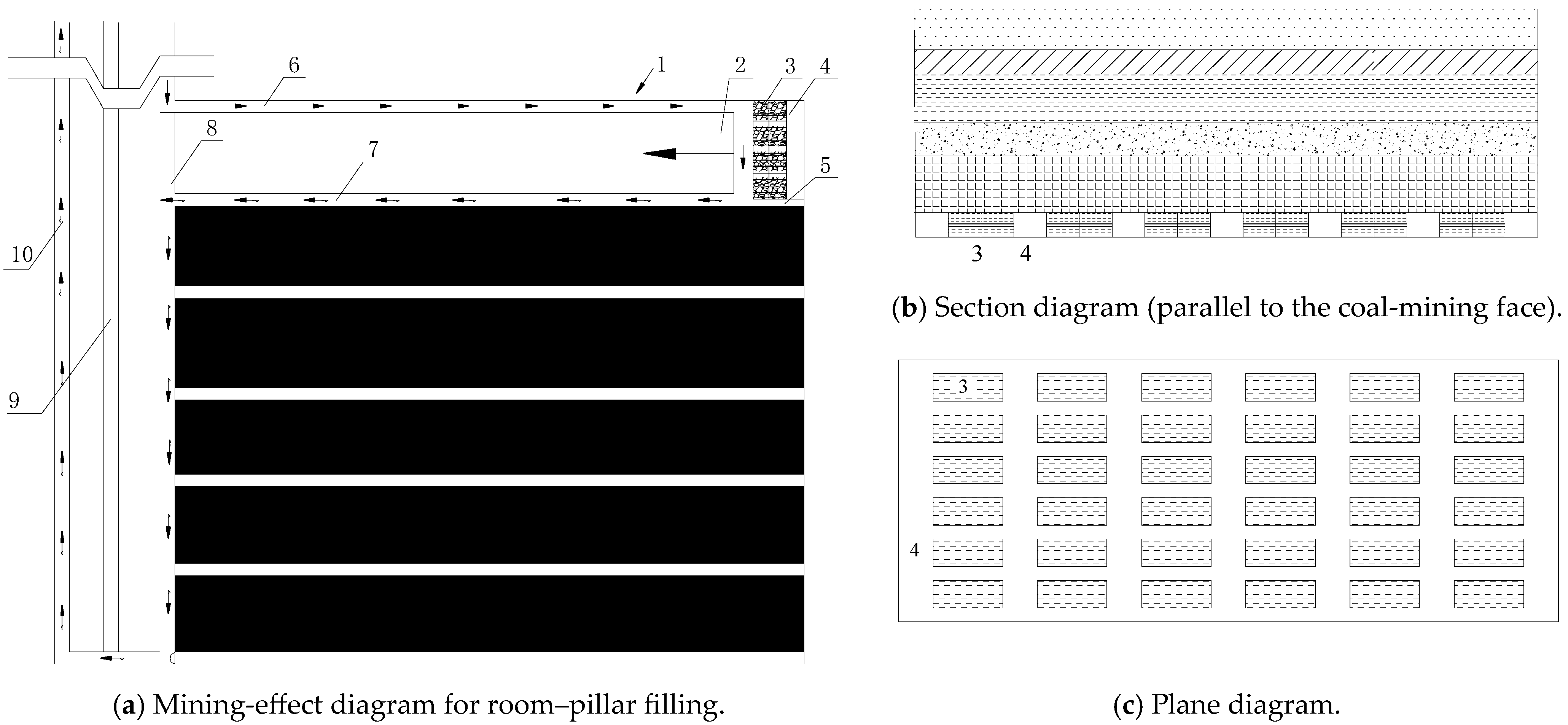

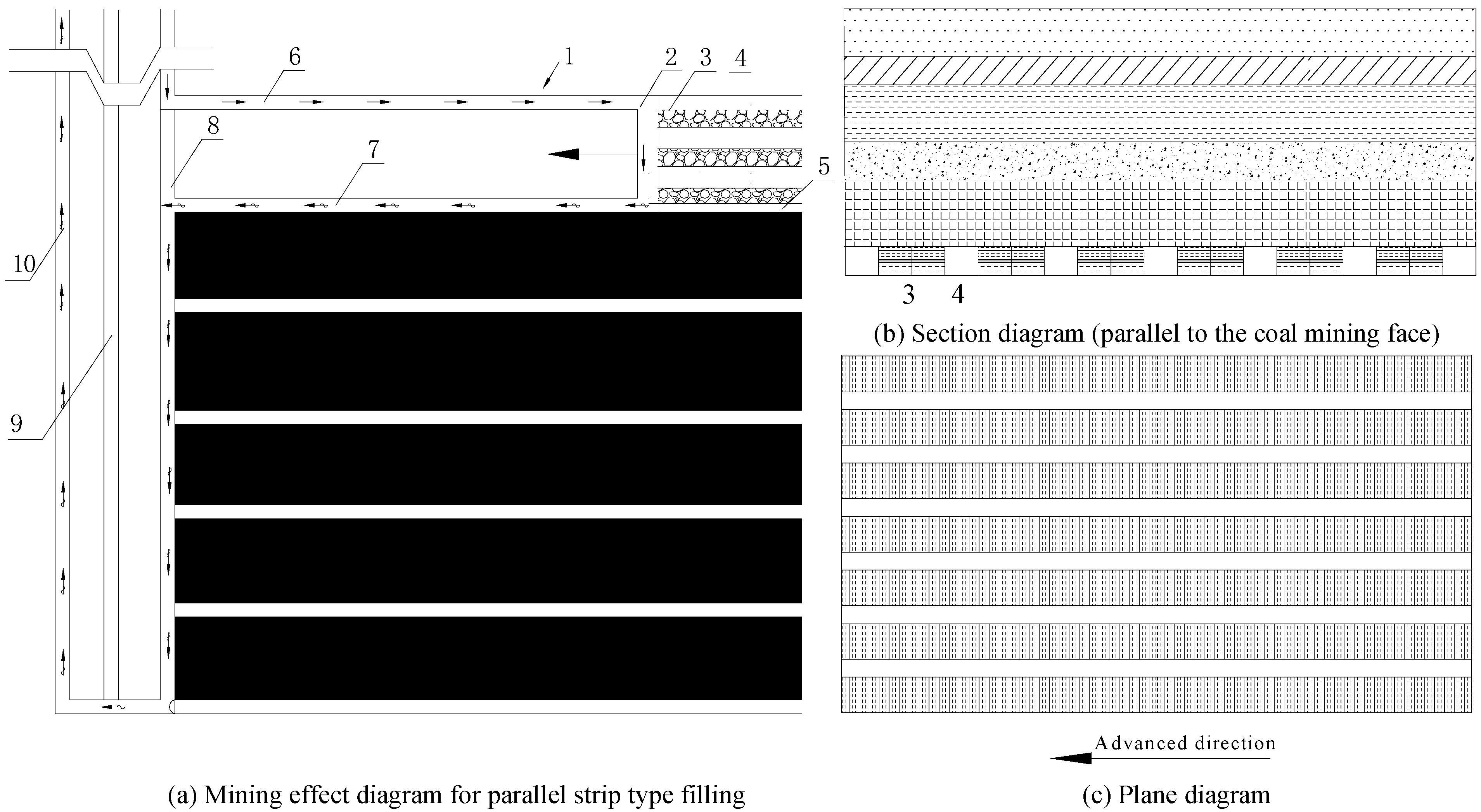
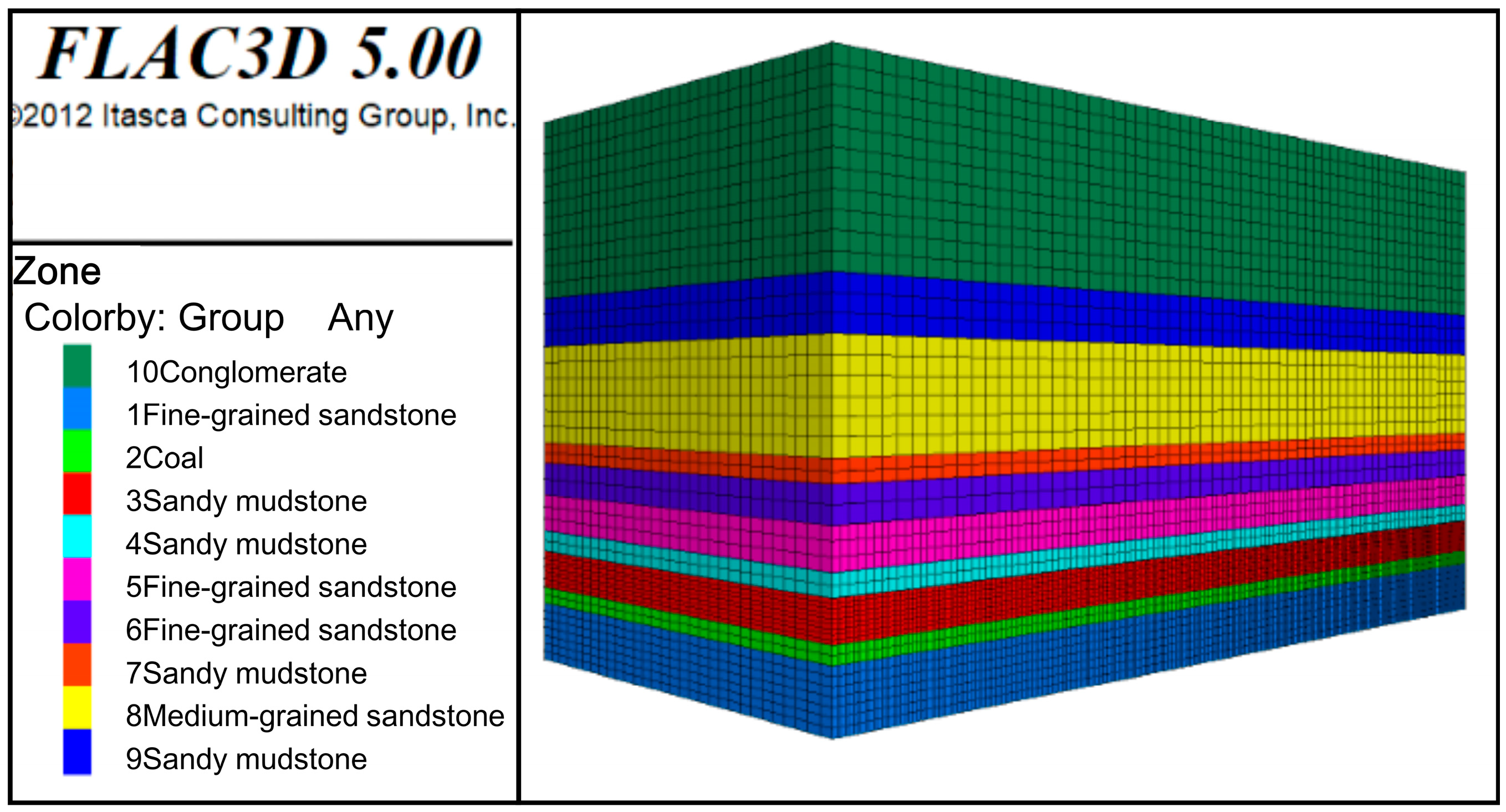


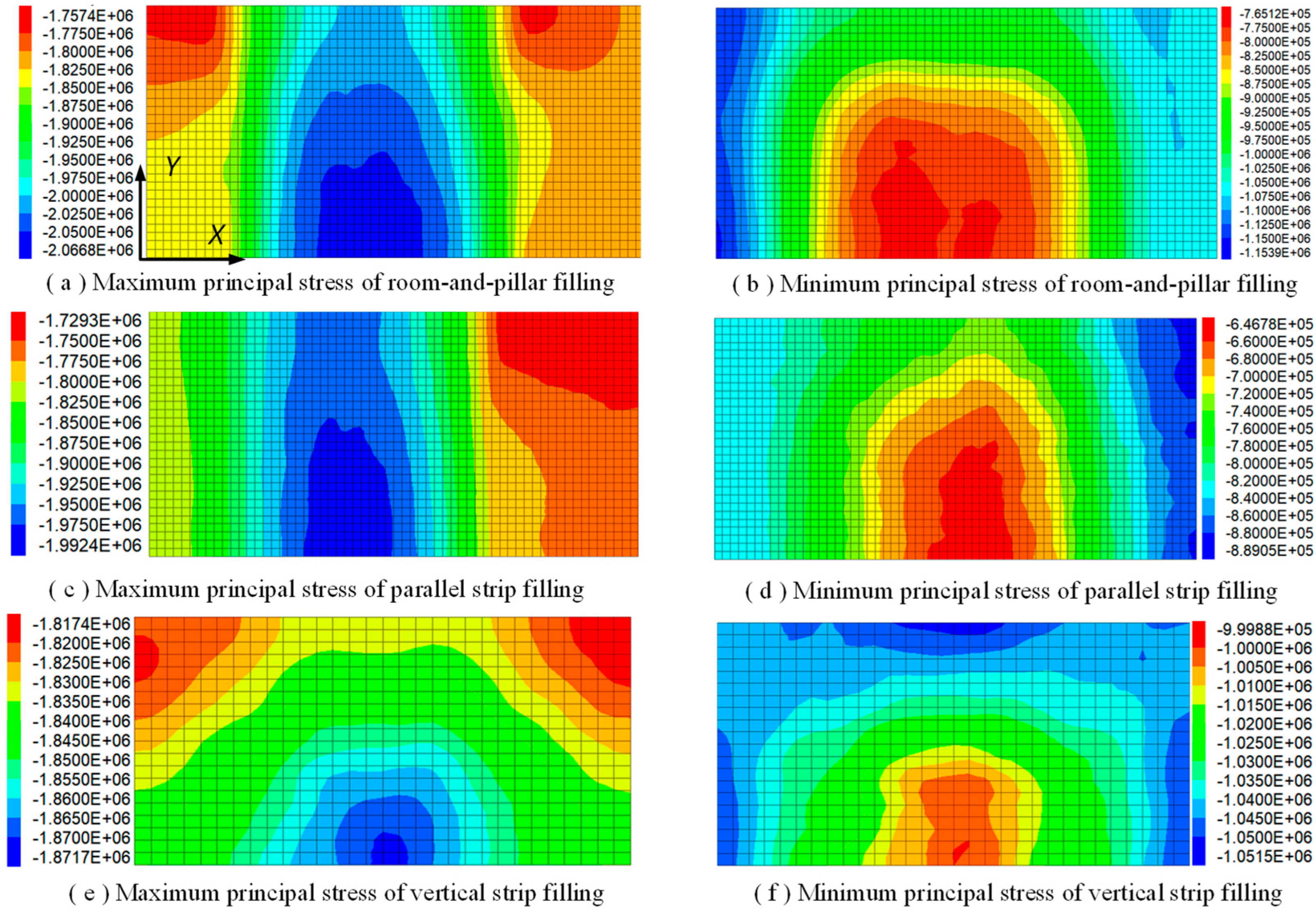

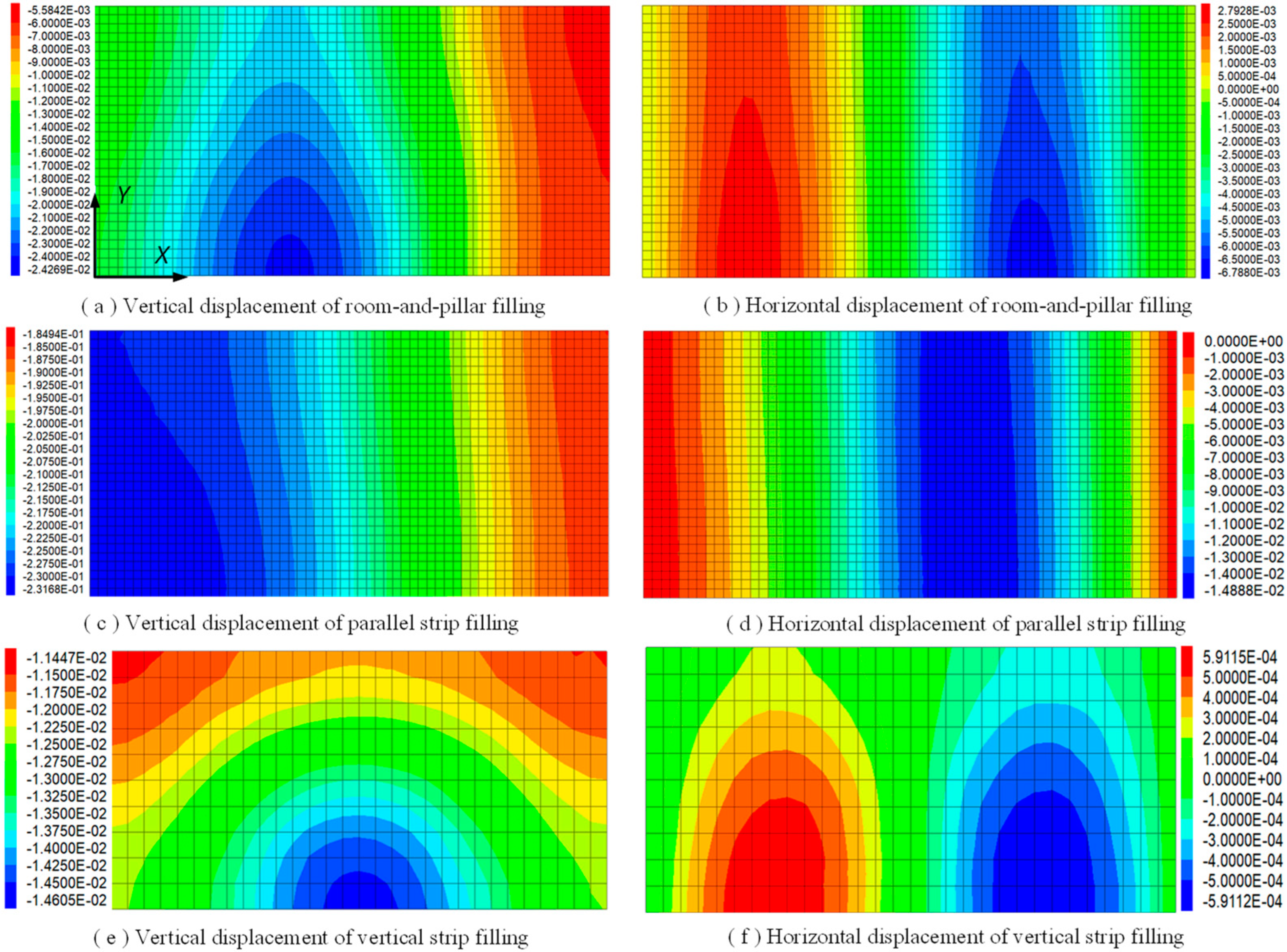



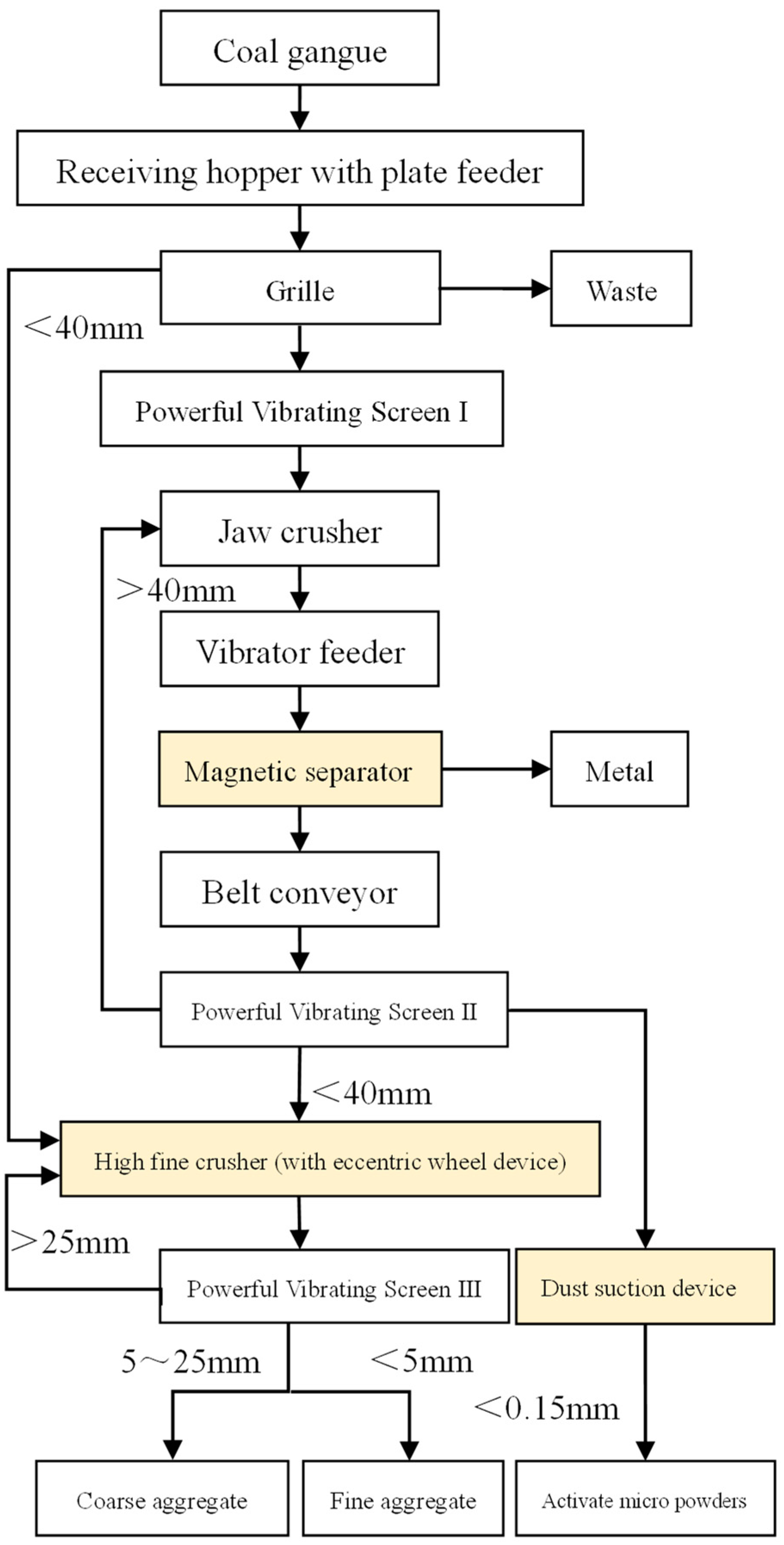



| ID | Lithology | Thickness /m | Volumetric Force/kN/m3 | Elastic Modulus/GPa | Compressive Strength/MPa | Tensile Strength/MPa | Friction Angle/° | Cohesion /MPa |
|---|---|---|---|---|---|---|---|---|
| 10 | Conglomerate | 44 | 22 | 1.30 | 11.90 | 1.13 | 31 | 1.11 |
| 9 | Sandy mudstone | 12 | 22 | 1.67 | 16.23 | 1.31 | 28 | 1.24 |
| 8 | Medium-grained sandstone | 24 | 24 | 2.83 | 21.23 | 1.90 | 33 | 1.93 |
| 7 | Sandy mudstone | 5 | 20 | 1.67 | 16.23 | 1.33 | 28 | 1.21 |
| 6 | Fine-grained sandstone | 8 | 26 | 3.35 | 28.43 | 2.10 | 33 | 2.14 |
| 5 | Fine-grained sandstone | 9 | 26 | 3.35 | 28.43 | 2.14 | 33 | 2.12 |
| 4 | Sandy mudstone | 5 | 22 | 1.67 | 16.23 | 1.61 | 28 | 1.23 |
| 3 | Sandy mudstone | 9 | 22 | 1.67 | 16.23 | 1.63 | 28 | 1.24 |
| 2 | Coal | 4 | 14 | 1.44 | 10.21 | 1.21 | 30 | 1.02 |
| 1 | Fine-grained sandstone | 14 | 26 | 3.35 | 28.43 | 2.14 | 33 | 2.12 |
| Paste Type | Slump/cm | Stratification/cm | Bleeding Rate/% | Fluidity/cm | Compression Strength/MPa | ||||
|---|---|---|---|---|---|---|---|---|---|
| 8 h | 1 d | 3 d | 7 d | 28 d | |||||
| Paste before optimization | 21.3 | 1.6 | 2.7 | 14.2 | 0.14 | 0.33 | 1.31 | 2.59 | 3.23 |
| Paste after optimization | 21.0 | 1.3 | 2.1 | 15.2 | 0.16 | 0.49 | 1.36 | 2.92 | 3.91 |
Disclaimer/Publisher’s Note: The statements, opinions and data contained in all publications are solely those of the individual author(s) and contributor(s) and not of MDPI and/or the editor(s). MDPI and/or the editor(s) disclaim responsibility for any injury to people or property resulting from any ideas, methods, instructions or products referred to in the content. |
© 2024 by the authors. Licensee MDPI, Basel, Switzerland. This article is an open access article distributed under the terms and conditions of the Creative Commons Attribution (CC BY) license (https://creativecommons.org/licenses/by/4.0/).
Share and Cite
Zhou, Y.; Wang, C.; Liao, C.; Wang, J.; Zhang, B. Study on the Mining Effect and Optimal Design of Longwall Full Mining with Paste Partial Filling. Minerals 2024, 14, 264. https://doi.org/10.3390/min14030264
Zhou Y, Wang C, Liao C, Wang J, Zhang B. Study on the Mining Effect and Optimal Design of Longwall Full Mining with Paste Partial Filling. Minerals. 2024; 14(3):264. https://doi.org/10.3390/min14030264
Chicago/Turabian StyleZhou, Yongqiang, Changxiang Wang, Changlong Liao, Jianhang Wang, and Baoliang Zhang. 2024. "Study on the Mining Effect and Optimal Design of Longwall Full Mining with Paste Partial Filling" Minerals 14, no. 3: 264. https://doi.org/10.3390/min14030264





